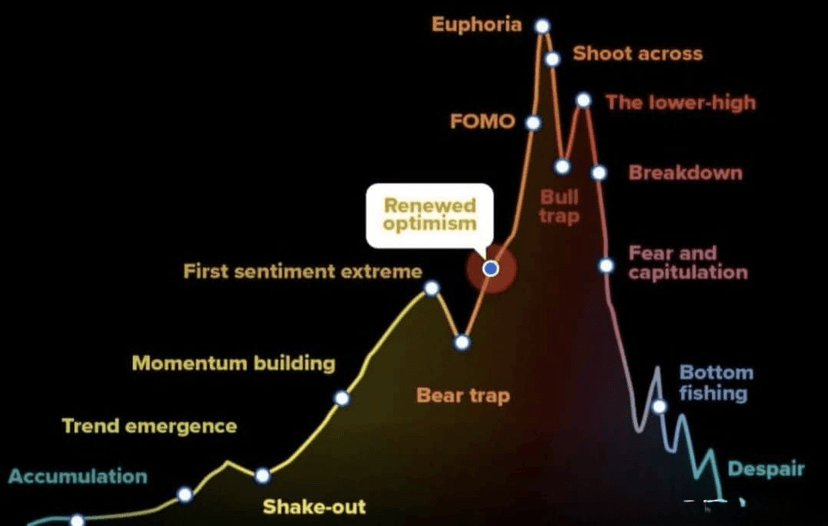1. Accumulation
This phase comes after a prolonged bear market when prices are relatively low and stable.
Only seasoned investors, “smart money,” and long-term believers are actively buying.
The general public is still disinterested because confidence is low.
News coverage is minimal, and sentiment is neutral to negative.

2. Trend Emergence
Prices begin to rise slowly due to increased buying pressure.
Early adopters notice potential upside.
The market starts forming a visible uptrend, but skepticism remains.
3. Momentum Building
More participants join as confidence grows.
Positive news starts circulating, and trading volumes increase.
The market sentiment shifts from cautious optimism to growing excitement.
4. Shake-out
A short-term pullback or correction happens, often due to profit-taking.
Weak hands (those with less conviction) sell out, thinking the rally is over.
This helps solidify the base before the next leg up.
5. First Sentiment Extreme
Price rallies again, surpassing previous resistance levels.
More media coverage begins, attracting attention from retail investors.
Sentiment becomes strongly bullish.
6. Bear Trap
A sudden sharp drop shakes investor confidence.
Traders fear this could be the start of another bear market and sell, but the dip is short-lived.
Strong buyers step in, causing the market to reverse quickly.
7. Renewed Optimism
Market rebounds, and participants believe the worst is over.
This renewed confidence fuels further buying, accelerating the uptrend.
8. FOMO (Fear of Missing Out)
Prices climb rapidly.
Even cautious investors jump in, afraid of missing profits.
New retail money floods in, and valuations stretch beyond fundamentals.
9. Euphoria
The peak of the cycle—prices are skyrocketing, and greed dominates.
Media hype is at its highest.
Many believe “this time is different” and that prices will never fall.
Risk-taking and leverage increase dangerously.
10. Shoot Across
The blow-off top phase—prices spike vertically.
Market is overextended, and any small trigger can cause sharp reversals.
11. The Lower-High
First major correction after the top.
Many believe it’s just a healthy pullback before more gains, so they buy again.
12. Breakdown
Selling pressure intensifies as reality sets in.
Fundamentals can’t justify high prices anymore.
Confidence starts crumbling, leading to panic selling.
13. Fear and Capitulation
The majority of latecomers sell at a loss.
Sentiment turns extremely negative.
Market participants swear off crypto entirely, calling it a scam or dead asset.
14. Bottom Fishing
Prices stabilize at much lower levels.
Value investors and long-term players cautiously re-enter.
Small rallies occur, but skepticism still dominates.
15. Despair
Lowest point of sentiment—investors feel hopeless.
Many abandon the market completely.
Ironically, this is often the best time to buy before the next accumulation phase starts.

